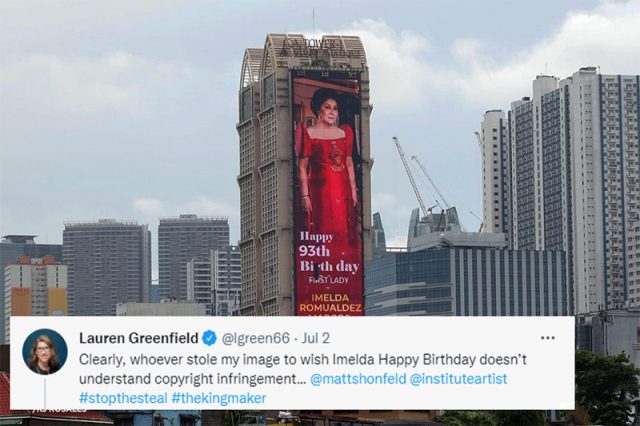
Billboards, which are commonly seen installed in the country’s expressways and avenues, are used for promotion and advertising. On rare occasions, people use it to acknowledge certain personalities.
Despite it being public in nature, billboards are not exempted from copyright law.
The issue of copyright infringement violation has been brought to discussion after Laura Greenfield, the director of the award-winning documentary “The Kingmaker,” called out the use of the picture of former first lady Imelda Marcos on a billboard in a greeting for the latter’s 93rd birthday.
The billboard installed along J.P. Rizal Avenue, Makati City bears Marcos’ picture in a red terno, which appeared on the theatrical release poster of the award-winning documentary “The Kingmaker.”
The greeting reads: Happy 93th (sic) birth day (sic) First Lady Imelda Romualdez Marcos.”
In her Twitter thread, Greenfield has identified the owner of the billboard company that installed the electronic billboard that used Marcos’ photo from “The Kingmaker” without consent.
“Clearly, whoever stole my image to wish Imelda Happy Birthday doesn’t understand copyright infringement,” Greenfield said in a tweet on July 2.
Clearly, whoever stole my image to wish Imelda Happy Birthday doesn’t understand copyright infringement… @mattshonfeld @instituteartist #stopthesteal #thekingmaker pic.twitter.com/KJbBFzvk9j
— Lauren Greenfield (@lgreen66) July 2, 2022
“Perhaps Mr. Alvin Carranza and Digital Out-of-Home PH can explain why they are involved in the copyright infringement of my work?” she also asked.
“The owner of the offending LED billboard company is Alvin Carranza, a known Marcos apologist. Regardless of his political views, the media industry is not going to appreciate copyright infringement as it puts everyone’s IP at risk of abuse. Bad business! dooh.ph,” the director continued.
What the law says
In the Philippines, the Republic Act No. 8293 or also known as the Intellectual Property Code (IP) protects various forms of intellectual property.
One that IP protects is the “literary and artistic works” which include books, writings, musical works, films, paintings, and even computer programs.
Greenfield’s concern falls under Part IV, Chapter 1, Section 172.1.k of the said code which protects “photographic works including works produced by a process analogous to photography; lantern slides.” Section 172.1.m also protects “pictorial illustrations and advertisements.”
Marcos’ photo in Greenfields’s documentary, for example, is classified as a photographic work used in a theatrical release poster for advertising the documentary, thus making it protected according to the said clauses.
What is allowed?
There are some provisions in the IP law that allows the public to grab content without permission.
One of which is the “fair use” according to Section 185 of the said code. “Fair use, or the use of the copyrighted material for “criticism, comment, news reporting, teaching including a limited number of copies for classroom use, scholarship, research, and similar purposes” is not an infringement of copyright.
The section also states that such factors must be observed for it to be considered a “fair use” practice:
- (he purpose and character of the use, including whether such use is of a commercial nature or is for non-profit educational purposes;
- The nature of the copyrighted work;
- The amount and substantiality of the portion used in relation to the copyrighted work as a whole; and
- The effect of the use upon the potential market for or value of the copyrighted work.
This is observed in most of the YouTubers and vloggers who make reaction videos on copyrighted videos such as trailers and gameplay videos.
Another exemption is when an individual reproduces one work for private use.
“Notwithstanding the provision of Section 177, and subject to the provisions of Subsection 187.2, the private reproduction of a published work in a single copy, where the reproduction is made by a natural person exclusively for research and private study, shall be permitted, without the authorization of the owner of copyright in the work,” section 187 of the IP stated.
Since the electronic billboard was used for greeting and was publicly displayed, it is no longer covered by “fair use” or private consumption.
RELATED: Acknowledging owners of photos, text with ‘CTTO’ may still be illegal
Apology
Meanwhile, hours after Greenfield’s tweet calling out the supposed copyright infringement violation, DOOH issued an apology.
“First, we would like to sincerely apologize for using your ‘Kingmaker’ image for our billboards,” the statement read.
“We must confess that we were unaware of your copyright, and we appreciate that you brought the matter to our attention. Please be informed that as soon as we were made aware of the issue, we immediately took the greeting down. We take full responsibility for the mistake, and we are truly sorry,” it added.
A second billboard was also spotted by social media users in Manila. It similarly bears the same picture of the Marcos matriarch in the same red terno and the same grammatical error on the greeting.
Greenfield likewise called out DOOH for this.
Getting reports of a second copyright infringement in Manila that occurred yesterday as well. Same company involved https://t.co/ePCTK355kx pic.twitter.com/EXatxEZvKo
— Lauren Greenfield (@lgreen66) July 3, 2022
As of writing, DOOH has not yet released a statement on the second billboard in question.
“The Kingmaker” is a 2019 documentary featuring the political career of the former first lady, whose son is now the president of the Philippines.









